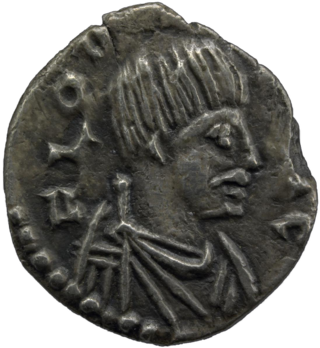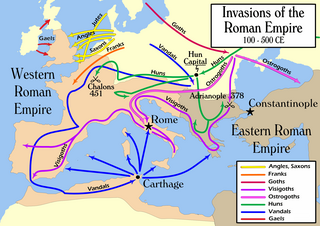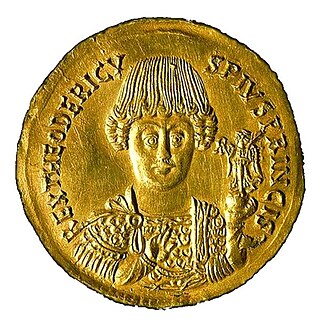Related Research Articles

Alboin was king of the Lombards from about 560 until 572. During his reign the Lombards ended their migrations by settling in Italy, the northern part of which Alboin conquered between 569 and 572. He had a lasting effect on Italy and the Pannonian Basin; in the former his invasion marked the beginning of centuries of Lombard rule, and in the latter his defeat of the Gepids and his departure from Pannonia ended the dominance there of the Germanic peoples.

The Goths were Germanic people who played a major role in the fall of the Western Roman Empire and the emergence of medieval Europe.

The Ostrogoths were a Roman-era Germanic people. In the 5th century, they followed the Visigoths in creating one of the two great Gothic kingdoms within the Roman Empire, based upon the large Gothic populations who had settled in the Balkans in the 4th century, having crossed the Lower Danube. While the Visigoths had formed under the leadership of Alaric I, the new Ostrogothic political entity which came to rule Italy was formed in the Balkans under the influence of the Amal dynasty, the family of Theodoric the Great.

Theodoricthe Great, also called Theodoric the Amal, was king of the Ostrogoths (471–526), and ruler of the independent Ostrogothic Kingdom of Italy between 493 and 526, regent of the Visigoths (511–526), and a patrician of the Eastern Roman Empire. As ruler of the combined Gothic realms, Theodoric controlled an empire stretching from the Atlantic Ocean to the Adriatic Sea. Though Theodoric himself only used the title 'king' (rex), some scholars characterize him as a Western Roman Emperor in all but name, since he ruled large parts of the former Western Roman Empire, had received the former Western imperial regalia from Constantinople in 497, and was referred to by the title augustus by some of his subjects.
The 450s decade ran from January 1, 450, to December 31, 459.
Year 489 (CDLXXXIX) was a common year starting on Sunday of the Julian calendar. At the time, it was known as the Year of the Consulship of Probinus and Eusebius. The denomination 489 for this year has been used since the early medieval period, when the Anno Domini calendar era became the prevalent method in Europe for naming years.

Odoacer, also spelled Odovacer or Odovacar, was a barbarian soldier and statesman from the Middle Danube who deposed the Western Roman child emperor Romulus Augustulus and became the ruler of Italy (476–493). Odoacer's overthrow of Romulus Augustulus is traditionally seen as marking the end of the Western Roman Empire as well as Ancient Rome.

The Heruli were an early Germanic people. Possibly originating in Scandinavia, the Heruli are first mentioned by Roman authors as one of several "Scythian" groups raiding Roman provinces in the Balkans and the Aegean Sea, attacking by land, and notably also by sea. During this time they reportedly lived near the Sea of Azov.

Totila, original name Baduila, was the penultimate King of the Ostrogoths, reigning from 541 to 552 AD. A skilled military and political leader, Totila reversed the tide of the Gothic War, recovering by 543 almost all the territories in Italy that the Eastern Roman Empire had captured from his Kingdom in 540.

The Rugii, Rogi or Rugians, were a Roman-era Germanic people. They were first clearly recorded by Tacitus, in his Germania who called them the Rugii, and located them near the south shore of the Baltic Sea. Some centuries later, they were considered one of the "Gothic" or "Scythian" peoples who were located in the Middle Danube region. Like several other Gothic peoples there, they possibly arrived in the area as allies of Attila until his death in 453. They settled in what is now Lower Austria after the defeat of the Huns at Nedao in 454.

The Migration Period, also known as the Barbarian Invasions, was a period in European history marked by large-scale migrations that saw the fall of the Western Roman Empire and subsequent settlement of its former territories by various tribes, and the establishment of the post-Roman kingdoms. The term refers to the important role played by the migration, invasion, and settlement of various tribes, notably the Franks, Goths, Alemanni, Alans, Huns, early Slavs, Pannonian Avars, Magyars, and Bulgars within or into the former Western Empire and Eastern Europe. The period is traditionally taken to have begun in AD 375 and ended in 568. Various factors contributed to this phenomenon of migration and invasion, and their role and significance are still widely discussed.

The Gepids were an East Germanic tribe who lived in the area of modern Romania, Hungary and Serbia, roughly between the Tisza, Sava and Carpathian Mountains. They were said to share the religion and language of the Goths and Vandals.
Mundus or Mundo was a Barbarian commander of Gepid, Hun, and/or Gothic origins. He appears to have been the son of the Gepid king Giesmus. In the early 500s he commanded a group of bandits in Pannonia, eventually allying himself to the Ostrogothic king Theodoric the Great. After Theodoric's death in 526, Mundus entered Byzantine service under emperor Justinian I, fighting in the Balkans, defending Justinian during the Nika riots, and fighting in the first stage of the Gothic War, during which he died in 536.

The Sciri, or Scirians, were a Germanic people. They are believed to have spoken an East Germanic language. Their name probably means "the pure ones".

The Ostrogothic Kingdom, officially the Kingdom of Italy, existed under the control of the Germanic Ostrogoths in Italy and neighbouring areas from 493 to 553.
Walter Andre Goffart is a German-born American historian who specializes in Late Antiquity and the European Middle Ages. He taught for many years in the history department and Centre for Medieval Studies of the University of Toronto (1960–1999), and is currently a senior research scholar at Yale University. He is the author of monographs on a ninth-century forgery, late Roman taxation, four "barbarian" historians, and historical atlases.
Eutharic Cilliga was an Ostrogothic prince from Iberia who, during the early 6th century, served as Roman Consul and "son in weapons" alongside the Byzantine emperor Justin I. He was the son-in-law and presumptive heir of the Ostrogoth king Theoderic the Great but died in AD 522 at the age of 42 before he could inherit Theoderic's title. Theoderic claimed that Eutharic was a descendant of the Gothic royal house of Amali and it was intended that his marriage to Theoderic's daughter Amalasuintha would unite the Gothic kingdoms, establish Theoderic's dynasty and further strengthen the Gothic hold over Italy.
Thurisind was king of the Gepids, an East Germanic Gothic people, from c. 548 to 560. He was the penultimate Gepid king, and succeeded King Elemund by staging a coup d'état and forcing the king's son into exile. Thurisind's kingdom, known as Gepidia, was located in Central Europe and had its centre in Sirmium, a former Roman city on the Sava River.
Turismod was a son of the king of the Gepids Thurisind. He was killed in 551 or 552 on the battlefield by Alboin, son of the king of the Lombards Audoin.
The Battle of Bolia, was a battle in 469 between the Ostrogoths and a coalition of Germanic tribes in the Roman province of Pannonia. It was fought on the south side of the Danube near its confluence with the river Bolia, in present-day Hungary. The Ostrogoths won, achieving supremacy in Pannonia, but soon migrated south towards richer lands.
References
- ↑ Goffart, Walter (25 November 2010). Barbarian Tides: The Migration Age and the Later Roman Empire. ISBN 978-0812200287.
- ↑ Hodgkin, Thomas. Theodoric the Goth: The Barbarian Champion of Civilization. ISBN 9780598453068.